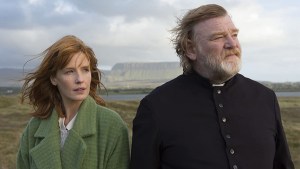St. Patrick’s Day is almost upon us and that means many of us will be watching “The Quiet Man” again. While it’s a fine film, it’s not the only Irish-themed picture available ─ by John Ford and others. A few suggestions for those who might be looking for something in addition to ─ or a little different ─ this holiday. In no particular order:
The Long Gray Line. (1955) Another John Ford classic. Tyrone Power stars as the real-life Martin Maher, an Irish immigrant who starts out as a waiter at West Point, joins the Army, gets assigned to the academy as an athletic instructor, and ends up staying at the Point for over 50 years. Naturally, he sees them all: Ike, Patton, Bradley, etc. Ford “company” members Maureen O’Hara and Ward Bond co-star, as well as Harry Carey Jr. as a dead ringer for the young Eisenhower. Watch for a young Peter Graves (of Mission: Impossible fame) in a cameo role.
The Informer(1935): Based on Liam O’Flaherty’s novel, it won Ford the first of his four Best Director Oscars. Victor McLaglen turns in the performance of a career as the disgraced Irish revolutionary Gypo Nolan, who sells his best friend to the British for 20 pounds and whose life falls apart as his treachery is discovered and guilt gnaws away at his soul.
The Plough and the Stars(1937): Another John Ford effort set in revolutionary Ireland, based on Sean O’Casey’s stage play. Barbara Stanwyck (unusual role for her) runs a rooming house in 1916 Dublin and wants nothing more than to stay out of the political ferment happening around her. But her husband (Preston Foster, also in The Informer), has other ideas. Ford regulars Barry Fitzgerald and Arthur Shields are there in support, as are Una O’Connor and Cyril McLaglen, Victor’s younger brother. The film’s climax, of course, is the 1916 Easter Rising.
Little Nellie Kelly(1940): Not John Ford, but Hollywood’s take on George M. Cohan’s hit 1922 stage musical-comedy. Judy Garland is always a delight, especially when she belts out “It’s a Great Day for the Irish” in the St. Patrick’s Day Parade number. Ronald Reagan’s old friend George Murphy is there, as well as Arthur Shields in a rare performance without his brother, Barry Fitzgerald.
The Irish in Us (1940): One of nine (!) pairings of Jimmy Cagney and Pat O’Brien, who star as two (of three) Irish-American brothers seeking success in America.
The Fighting 69th (1940): The year 1940 was a banner one for Irish-themed films and The Fighting 69th was made with a specific purpose in mind. As World War II was breaking out in Europe, many Irish-Americans were still seething over what they saw as being asked to fight for Britain in World War I while British troops were repressing Irish nationalists in Ireland. As a result, they were among the most isolationist of voters. The Fighting 69th was one of Hollywood’s many films in this period that were intended to build public support for eventual US intervention.
The film centers on the exploits of the famed New York National Guard regiment in the trenches of World War I. Fan favorite Jimmy Cagney as tough guy Irish street kid Jerry Plunkett enlists and causes mayhem for his superiors and comrades before finding nobility at the end. While Plunkett is a fictional character, Chaplain Father Francis Duffy (Pat O’Brien again), 69th commander William “Wild Bill” Donovan (George Brent), and poet Joyce Kilmer (author of “Trees,” played by Jeffrey Lynn), were real people. William Hopper (Paul Drake on Perry Mason) and George Reeves (Superman) appear in small roles.
My Wild Irish Rose (1947) This fictionalized biopic of tenor Chauncey Olcott features the seriously underrated Dennis Morgan (who also appeared in The Fighting 69th and has a beautiful voice.) If you are simply a fan of musical biopics chockablock with nostalgic song and dance, you are in for a Technicolor treat.
As the Irish assimilated into American society in the 1950s and 1960s, the number of “Irish” films coming out of Hollywood fell off, but not entirely. And other outlets picked up the slack. More worth considering:
The Molly Maguires (1970): Who can resist Sean Connery and Richard Harris? Filmed in Schuylkill County, Pennsylvania where the actual events took place, the action follows a detective (Harris) sent to investigate the rumored existence of a secret society among the Irish coal miners dedicated to resisting their exploitation by the mine owners. Connery is the target. The Irish-themed score by Henry Mancini is especially notable.
The Brylcreen Boys (1998):A rom-com that focuses on a little-known aspect of World War II: The Allied and German airmen who crash-landed in neutral Ireland and were interned ─ in the same camp! Directed by Terence Ryan, it stars Billy Campbell, Angus Macfadyen, Jean Butler and Gabriel Byrne. Campbell and Macfayden play rival Canadian and German pilots who fall for the same local Irish girl (Butler), while camp commandant Byrne tries to keep things from getting out of hand.
There are many more, of course: Neil Jordan’s 1996 epic biopic Michael Collins, starring Liam Neeson, 2006’s The Wind That Shakes the Barley, both set in revolutionary Ireland, 1997’s The Boxer, starring Daniel Day-Lewis, and Kenneth Branagh’s Belfast, just released this year.
I’m sure there are ones I’ve missed. So, by all means watch The Quiet Man, but don’t forget that there’s plenty more green on the screen to enjoy.



